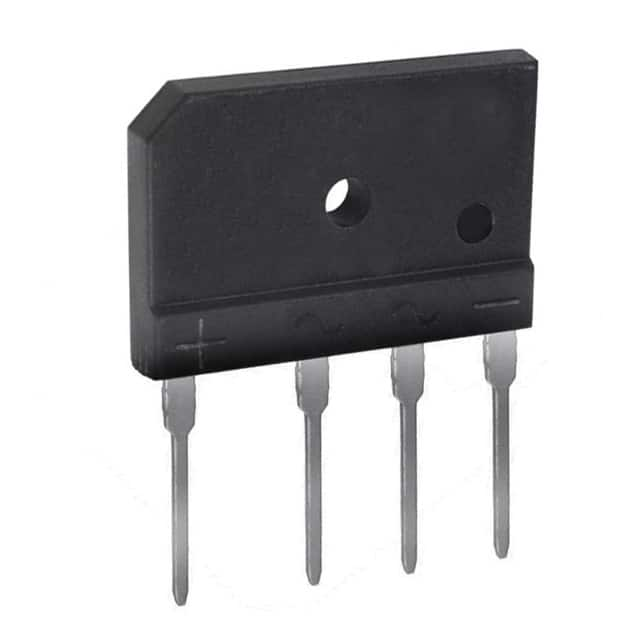GBJ806 Diode Bridge Rectifier
Introduction
The GBJ806 diode bridge rectifier is a crucial component in electronic circuits, primarily used for converting alternating current (AC) to direct current (DC). This entry provides an overview of the GBJ806 diode bridge rectifier, including its product details, specifications, pin configuration, functional features, advantages and disadvantages, working principles, application field plans, and alternative models.
Product Overview
- Category: Electronic Components
- Use: Converting AC to DC in electronic circuits
- Characteristics: High efficiency, low forward voltage drop, compact design
- Package: Through-hole or surface mount
- Essence: Reliable rectification of AC power to DC
- Packaging/Quantity: Typically available in reels or tubes containing multiple units
Specifications
- Maximum Average Forward Current: 8A
- Peak Repetitive Reverse Voltage: 600V
- Maximum DC Blocking Voltage: 600V
- Operating Temperature Range: -55°C to +150°C
- Storage Temperature Range: -55°C to +150°C
Detailed Pin Configuration
The GBJ806 diode bridge rectifier typically consists of four pins arranged in a specific configuration. The pinout configuration is as follows: 1. Pin 1: AC Input Terminal 1 2. Pin 2: AC Input Terminal 2 3. Pin 3: Positive DC Output 4. Pin 4: Negative DC Output
Functional Features
- Efficiently converts AC to DC
- Low forward voltage drop minimizes power loss
- Compact design for space-constrained applications
- Reliable and durable construction for long-term use
Advantages and Disadvantages
Advantages
- High efficiency in converting AC to DC
- Low power dissipation due to low forward voltage drop
- Compact size allows for versatile integration into various circuit designs
Disadvantages
- Limited maximum average forward current compared to higher-rated diode bridge rectifiers
- Not suitable for applications requiring very high current handling capabilities
Working Principles
The GBJ806 diode bridge rectifier operates on the principle of rectification, where it utilizes a configuration of diodes to allow current flow in only one direction, effectively converting AC input to DC output. When AC voltage is applied to the input terminals, the diode bridge rectifier ensures that the output remains predominantly in one polarity, enabling the conversion process.
Detailed Application Field Plans
The GBJ806 diode bridge rectifier finds extensive use in various electronic applications, including but not limited to: - Power supplies - Battery chargers - Motor drives - LED lighting systems - Audio amplifiers
Detailed and Complete Alternative Models
For applications requiring different specifications or performance characteristics, several alternative models can be considered as replacements for the GBJ806 diode bridge rectifier. Some notable alternatives include: - GBJ1006: Similar package and pin configuration with a higher maximum average forward current rating - GBJ2006: Higher peak repetitive reverse voltage and maximum DC blocking voltage for increased voltage handling capabilities - GBJ4006: Enhanced thermal performance and lower forward voltage drop for improved efficiency
In conclusion, the GBJ806 diode bridge rectifier serves as a vital component in electronic circuits, offering efficient AC to DC conversion with its unique characteristics and functional features. Understanding its specifications, pin configuration, advantages, disadvantages, working principles, application field plans, and alternative models is essential for integrating this component effectively into diverse electronic designs.
Word Count: 498
Lista 10 Vanliga frågor och svar relaterade till tillämpningen av GBJ806 i tekniska lösningar
What is GBJ806?
- GBJ806 is a standard for technical solutions related to electrical and electronic equipment.
How does GBJ806 impact technical solutions?
- GBJ806 sets requirements for the design, production, and testing of electrical and electronic equipment to ensure safety and reliability.
Is compliance with GBJ806 mandatory?
- Yes, compliance with GBJ806 is mandatory for electrical and electronic equipment to be sold or used in certain regions.
What are the key safety considerations addressed by GBJ806?
- GBJ806 addresses safety considerations such as insulation, grounding, and protection against electric shock.
Does GBJ806 cover environmental aspects of technical solutions?
- Yes, GBJ806 also covers environmental aspects such as the restriction of hazardous substances in electrical and electronic equipment.
Are there specific testing requirements outlined in GBJ806?
- Yes, GBJ806 specifies testing requirements for electrical and electronic equipment to ensure compliance with safety and performance standards.
How can I ensure my technical solution complies with GBJ806?
- To ensure compliance, it is important to design and test the technical solution according to the requirements outlined in GBJ806.
What are the consequences of non-compliance with GBJ806?
- Non-compliance with GBJ806 can result in legal penalties, product recalls, and damage to the reputation of the manufacturer.
Are there any industry certifications related to GBJ806 compliance?
- Yes, there are industry certifications that demonstrate compliance with GBJ806, providing assurance to customers and regulatory authorities.
Can GBJ806 requirements change over time?
- Yes, GBJ806 requirements may be updated periodically to reflect advancements in technology and changes in safety standards.


